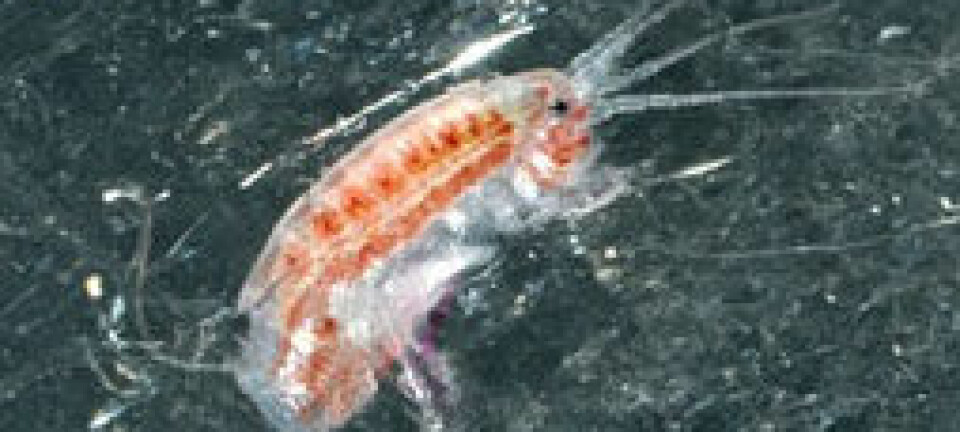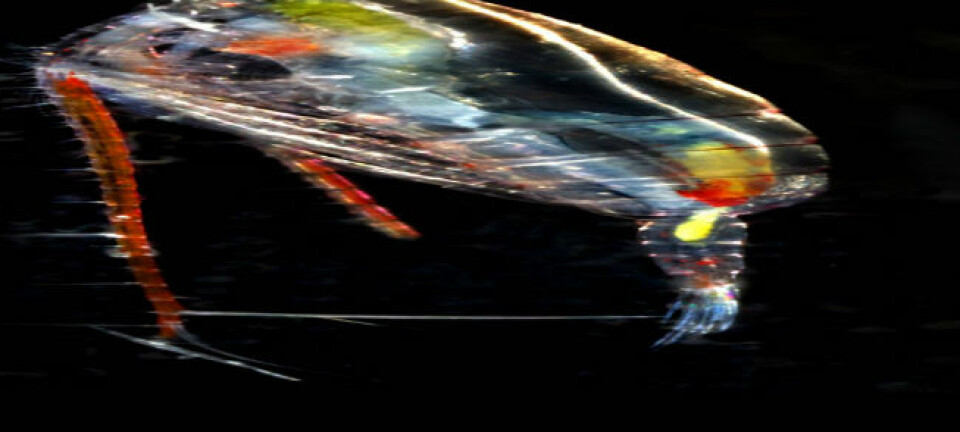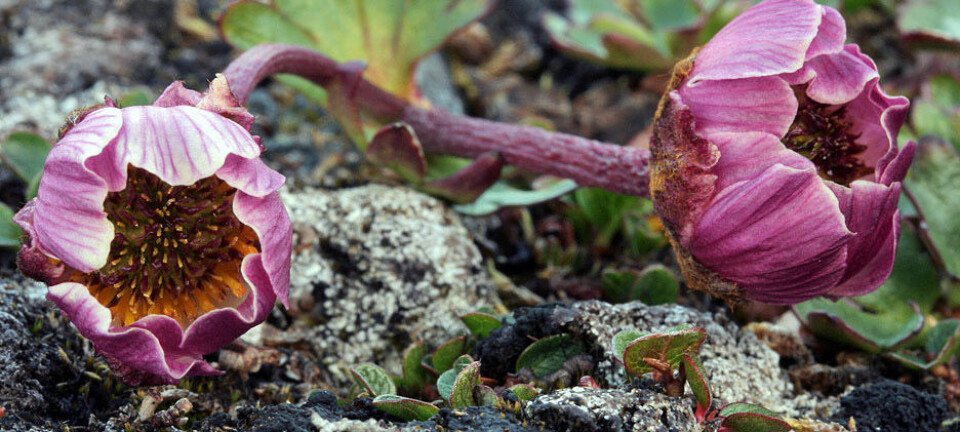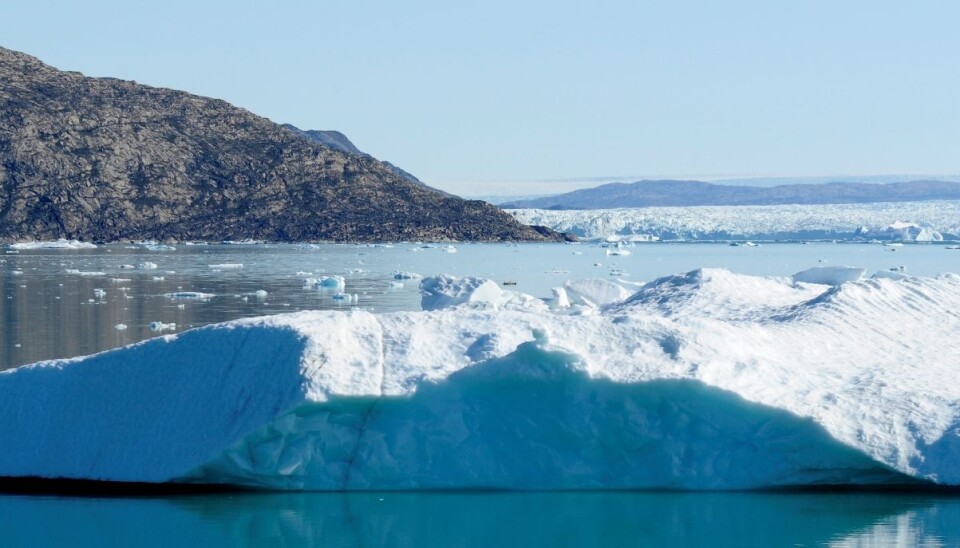
Hitchhiking with ocean currents
Marine animals living on Arctic ice seem destined for a catastrophe if all the summer ice melts. But a tiny krill can survive by hitchhiking north with ocean currents.
Denne artikkelen er over ti år gammel og kan inneholde utdatert informasjon.
Arctic Sea ice is melting in summer months at an alarming rate. Several reports this autumn conclude that the ice covering has shrunk more than ever. And it’s likely to get worse.
Lots of scientists have estimated that the Arctic Ocean can be ice-free during summers in about 30 years. Such a dramatic change is bound to have enormous consequences.
It should be especially hard for any creatures that live on, in or under the ice. But for one species the future looks a little more secure than scientists have thought.
It’s a tiny shrimp-like crustacean that feeds on algae on the underside of sea ice. Its scientific name is Apherusa glacialis, but Jørgen Berge, a professor in Arctic and Marine Biology at the University of Tromsø generally calls it by its Norwegian name 'sjøisåte', or 'sea ice krill'.

Following an expedition to the Fram Strait and the Arctic Ocean north of Svalbard in January 2012, Berge and his Norwegian and US colleagues think this little amphipod can survive ice-free summers.
Importantly, this means fish that feed on it, and animals further up the food chain such as seals and polar bears, will have a better chance of surviving the warmer summers ahead.
Nemo hypotheses
Previously, researchers thought this krill spent its entire life on the underside of the Arctic Sea ice. During the winter expedition, headed by Stig Falk-Pettersen from the Norwegian Polar Institute, the scientists made discoveries that made them think again.
The researchers refer to their new model as the 'Nemo Hypotheses' after the animated film, Finding Nemo, in which the clownfish Marlin, pictured below, catches a long ride with sea currents.

They were quite surprised when the same crustaceans turned up in all their fine-meshed samplings taken at depths from 200 to 2,000 metres – but not in samples taken closer to the surface, right below the sea ice.
The scientists have developed a model on the basis of these samples in which these krill spend an important stage of their lives in open water, a pelagic phase. In this model they use the deep-sea currents as a transport system and as a key to surviving ice-free summers.
Scientists used to think any of these under-ice crustaceans that lost their habitat when the ice melted were either carried out through the Fram Strait or sank to the seabed. Either option would mean the ringing of a death knell for a species believed to be completely reliant on sea ice and a polar climate.
“However, according to the Nemo hyopthesis the under-ice krill isn’t passively and fatally exposed to the sea when the ice melts or is transported out of the Arctic Ocean. Rather, it actively uses the deep-sea currents that flow into the Arctic Ocean for survival and transport,” explains Berge.
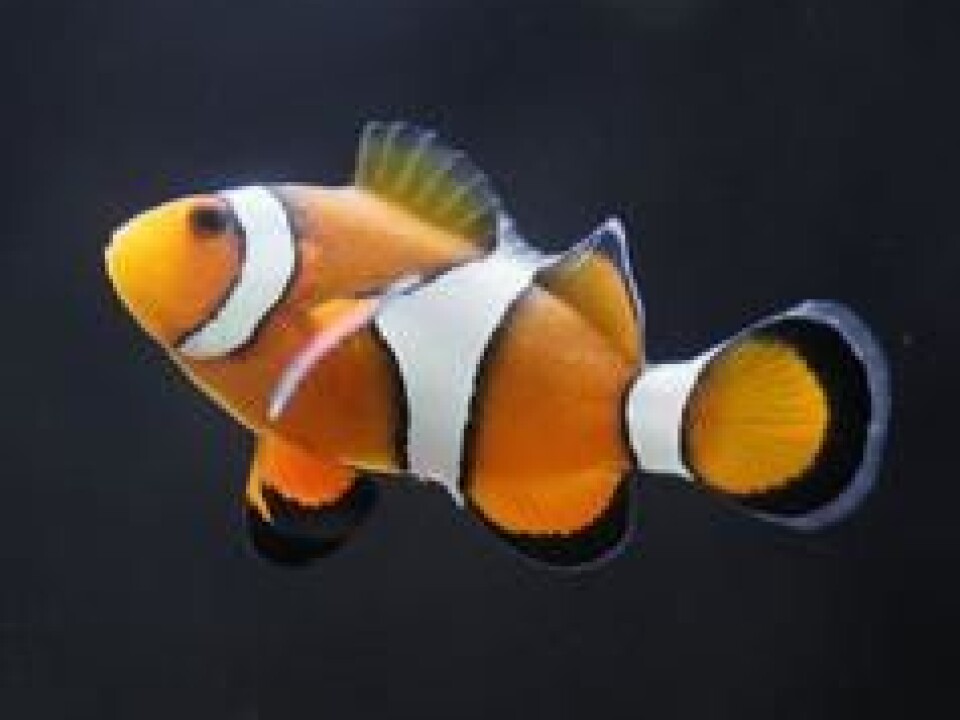
“By migrating down into the depths to the deep Atlantic Ocean current, it gets transported in the opposite direction of the ice drifts and can thus colonise new ice in the Arctic Ocean in the early winter.”
As the deep ocean currents flow toward the North Pole much faster than the transpolar ice drift, Berge and his colleagues estimate that two or three months in deep water is enough to counteract nine or ten months of ice drift. So the current takes them back north in the Arctic Ocean where they can migrate up the water column and once again attach to the underside of newly-formed sea ice during the spring algae blooms.
“If they use the ocean currents for transport back into the Arctic Ocean they would have to migrate up towards the surface at some point," says the professor. "This is an important supposition and one of the really exciting potential subjects for future research would be the documentation of this upwards migration.”
Survival strategy
The researchers found the krill in deep water in January in the middle of the polar night. This is a period when the sea ice makes headway rather than melting. It’s still uncertain whether the creatures simply allow themselves to sink when the ice melts or whether they actively migrate downwards in midwinter.
“Of course this is only speculation but our interpretation is that A. glacialis could migrate actively down in the middle of the polar night when there is little [algal food] production associated with the ice. There could actually be more nutrients in the deep Atlantic Ocean current than towards the surface and the ice,” says Berge.
“By migrating vertically downwards in the winter the sea ice krill can dramatically improve survivability in the Arctic Ocean without losing any potential feeding opportunities in the ice. In the autumn, however, when they are released by melting ice, it’s feasible that a migration downwards into the depths is an evolutionary trait bolstering their survivability in ice-free periods.”
According to the professor, such a migration can explain what has appeared to be a paradox. How has this amphipod maintained a large and viable population over time when its expected habitat is reduced as much as 80 percent every summer by melting and ice drift?
If the Nemo hypothesis is correct, this could also explain how A. glacialis survived previous spells with ice-free summers, which have occurred several times in the past 12,000 years.
Good news on the ice front
If the amphipod has survived extensive periods with ice-free summers before, then it can do it again. This would be good news for other Arctic organisms such as polar cod, birds, seals and even polar bears.
“If the theory is correct it means a vital link in the food chain doesn’t die out. The amphipod might become less prolific but it provides hope that it won’t disappear. The consequences are beneficial to the rest of the food chain,” says Berge.
Although the Nemo hypothesis is based on a very limited data set, Berge is convinced that it’s right and it’s important. Nevertheless, researchers still lack plenty of knowledge about the amphipod and the Arctic marine ecosystem in general and the consequences of a possible disappearance of the Arctic summer ice.
Few scientific expeditions have been conducted in winter in the Arctic Ocean and the long, frigid polar night still holds many vital secrets.
“We’ll try to organise more Arctic expeditions in the polar night. Among other things we’re working with the Norwegian Polar Institute to get this included in the plans for letting the research ship Lance freeze into the ice next winter,” says Berge.
------------------------------
Read the Norwegian version of this article at forskning.no
Translated by: Glenn Ostling







